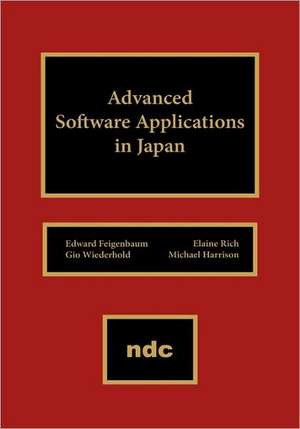Advanced Software Applications in Japan
Autor Edward A. Feigenbaum, Elaine Rich, Gio Wiederhold, Michael G Harrisonen Limba Engleză Hardback – 31 dec 1994
Preț: 525.48 lei
Preț vechi: 656.86 lei
-20% Nou
Puncte Express: 788
Preț estimativ în valută:
100.58€ • 104.60$ • 84.28£
100.58€ • 104.60$ • 84.28£
Carte tipărită la comandă
Livrare economică 13-27 martie
Preluare comenzi: 021 569.72.76
Specificații
ISBN-13: 9780815513605
ISBN-10: 0815513607
Pagini: 676
Dimensiuni: 175 x 245 x 48 mm
Greutate: 1.65 kg
Editura: ELSEVIER SCIENCE
ISBN-10: 0815513607
Pagini: 676
Dimensiuni: 175 x 245 x 48 mm
Greutate: 1.65 kg
Editura: ELSEVIER SCIENCE
Cuprins
Part I Knowledge-Based Systems in Japan Executive Summary 1. Introduction Expert Systems and Artificial Intelligence The Applications of Expert Systems Benefits to End Users The Expert Systems Business Advanced Research in Knowledge-Based Systems: Inventing the Next Generation Design of the JTEC Study Group on Knowledge-Based Systems and the Selection of Japanese Sites 2. Applications of Knowledge-Based Systems in Japan Trends in AI Applications in Japan Case Studies of High-Impact Systems Types of Applications Company-Specific Applications Observations and Conclusions 3. Tools and Infrastructure for Knowledge-Based Systems Introduction Expert Systems Building Tools: Definitions Profile of a Tool: ES/KERNEL2 Profile of a Tool Vendor: Hitachi Infrastructure: Industrial Research and Technology Transfer Observations and Conclusions 4. Advanced Knowledge-Based Systems Research University Research Industrial Research 5. National AI Research Projects Introduction Electronic Dictionary Research (EDR) Project ICOT Fuzzy Logic Research and Life Real World Computing (RWC) Project 6. Integration of ES with Conventional Data Processing Systems Introduction Integration with Physical Systems Integration of Problem-Solving Techniques Future Visions Analysis 7. Business Perspective History and Trends Business Advantages of KBS Technology Business Impact on the Japanese Computer Manufacturers (JCMs) Business Impact on Non-JCM Companies Comparison with Conventional Data Processing Problems with Current Generation KBS Technology Are Knowledge-Based Systems a Business? Conclusions 8. Conclusions Business Sector Applications of Expert Systems in Japan Knowledge-Based Systems Research in Japan ICOT Research Program Progress EDR Program Progress Appendices Appendix A: Professional Experience of Panel Members Appendix B: Professional Experience of Other Team Members Appendix C: Questionnaire Appendix D: Sites Visited by JTEC Team Appendix E: Site Reports Appendix F: Bibliography Appendix G: GlossaryPart II Database Use and Technology in Japan Executive Summary 1. Introduction 1.1 Coverage 1.2 Motivation 1.3 Overview 2. Database Research Infrastructure 2.1 Role of the Japanese Government in Database Activities 2.2 Funding Sources 2.3 International Collaboration 2.4 U.S. Influence and Faddism 2.5 Conclusions 3. Technology Topics 3.1 Object Databases 3.2 Knowledge Bases 3.3 Multimedia Database Systems 3.4 Interoperable Databases 3.5 Database Hardware 3.6 Security 3.7 Database Tools 3.8 Database Management Systems (DBMSs) 3.9 Summary 4. DBMS Product Infrastructure 4.1 DBMS Technology Channels 4.2 DBMS Market Drivers 4.3 Japanese Positioning 4.4 The Japanese Response to the Global Database Market 4.5 Observations 5. Database Use Industry 5.1 Database Search Services 5.2 Databases as Export Products 5.3 Database Technology 5.4 Summary Assessment 6. Summary 6.1 Multimedia Databases 6.2 Government and Database Research and Development Appendices Participants' Biographies Sites Visited and Contacts Trip Reports BibliographyPart III Machine Translation in Japan Executive Summary 1. Introduction: Machine Translation in Japan and the U.S. 1.1 The State of the Art in Machine Translation 1.2 The Role of Machine Translation 1.3 An Historical Sketch of Machine Translation 1.4 The Japanese View of Machine Translation 1.5 A Comparative Analysis of Japanese and U.S. Machine Translation 1.6 Paradigms for Machine Translation 1.7 Structure of the Report 2. Technical Infrastructure 2.1 Overview of the Translation Process 2.2 Translation Stages of the Linguistic Processor 2.3 Analysis 2.4 Transfer 2.5 Generation 3. Languages and Application Domains 3.1 Current Range of Source and Target Languages 3.2 Addition of New Source and Target Languages 3.3 Application Domains, Domain Adaptability 4. Knowledge Sources for Machine Translation 4.1 Overview of Knowledge Sources 4.2 Use of Knowledge Sources in Specific Japanese MT Systems 4.3 Knowledge Sources and Linguistic Theory 4.4 Lexicon Samples 5. Life Cycle of Machine Translation Systems 5.1 Research Prototype 5.2 Operational Prototype 5.3 Practical System (Special-Purpose) 5.4 Commercial System (General-Purpose) 5.5 Ongoing Use 6. The Uses of Machine Translation in Japan 6.1 Introduction 6.2 User Sites Visited 6.3 MT Users: The Vendor Perspective 6.4 The Broader Outlook 7. Acceptance of MT: Quality and Productivity 7.1 Productivity and Cost 7.2 Translation Quality 7.3 Throughput 7.4 Customization 7.5 Integration 7.6 Open Systems and Software Portability 8. MT Contrasts Between the U.S. and Europe 8.1 Major MT Centers and Systems in the U.S. 8.2 Influences Among MT Groups 8.3 Current European Systems 9. Research and Development 9.1 Interlingua-Based Translation 9.2 Example-Based Translation 9.3 Transfer-Driven Translation 9.4 Grammars 9.5 Generation 9.6 Dictionaries 9.7 Discourse-Level Issues 9.8 Better Tools for Users 9.9 Extension to Other Languages 9.10 Speech-to-Speech Translation 9.11 Embedded MT Systems 9.12 Massively Parallel Hardware 9.13 The Future 10. Future Directions in Machine Translation 11. References Appendix I: Japanese Sites in Part III Report Appendix II: Biographies of Panel Members Appendix III: Abbreviations Used in Part IIIPart IV Advanced Computing in Japan 1. Executive Summary The Technical Bottom Line 2. Computing in Japan 2.1 Organization 2.2 Preview of the Report 2.3 Science and Technology 2.4 Advice for Future Panels 2.5 Acknowledgements 3. Electronic Components, Chips and Packaging 3.1 Introduction 3.2 Discussion 3.3 Summary 3.4 Projections for the Future 4. Data Storage 4.1 Introduction 4.2 Disk Drive Technology 4.3 Recording in Japan 4.4 Overview 5. Computer Architecture 5.1 Overview 5.2 Response to Questions 5.3 Interactions Between Japanese and Foreign Researchers 5.4 Computing Environment in Japan 5.5 Detailed Observations 5.6 Observations, Impressions, and Scenarios 5.7 A Survey of Computer Architectures 6. Progress in Software and Software Engineering 6.1 Introduction 6.2 The Computer Business 6.3 The Life of a Software Professional 6.4 Tools 6.5 Methodology 6.6 Measured Performance 6.7 Speculations 6.8 Operating Systems 6.9 Programming Languages 6.10 General Attitudes 6.11 Recommended Further Studies 7. Multimedia and Human Interfaces 7.1 Introduction 7.2 Japanese Industrial Work 7.3 Japanese Government Projects 7.4 Conclusions 8. TRON 8.1 Introduction 8.2 TRON and Trade Friction 8.3 Summary 9. Advanced Scientific Computing in Japan 9.1 Introduction 9.2 Overview of Academic Supercomputer Centers 9.3 Networking in Japan 9.4 Institute for Molecular Sciences 9.5 University of Tokyo Computing Center 9.6 Protein Engineering Research Institute 9.7 Institute of Computational Fluid Dynamics 9.8 Comparisons Between U.S. and Japan Appendix A: Personnel and Agendas A.1 Biographical Sketches A.2 Itinerary of JTEC Panel in Japan A.3 Agenda of Kickoff Meeting, July 11, 1989 A.4 Agenda of Oral Report Meeting, December 8, 1989 Appendix B: Trip Report B.1 Introduction B.2 Monday, November 6 B.3 Tuesday, November 7 B.4 Wednesday, November 8 B.5 Thursday, November 9 B.6 Friday, November 10 B.7 A Computer Architecture Survey Bibliography








